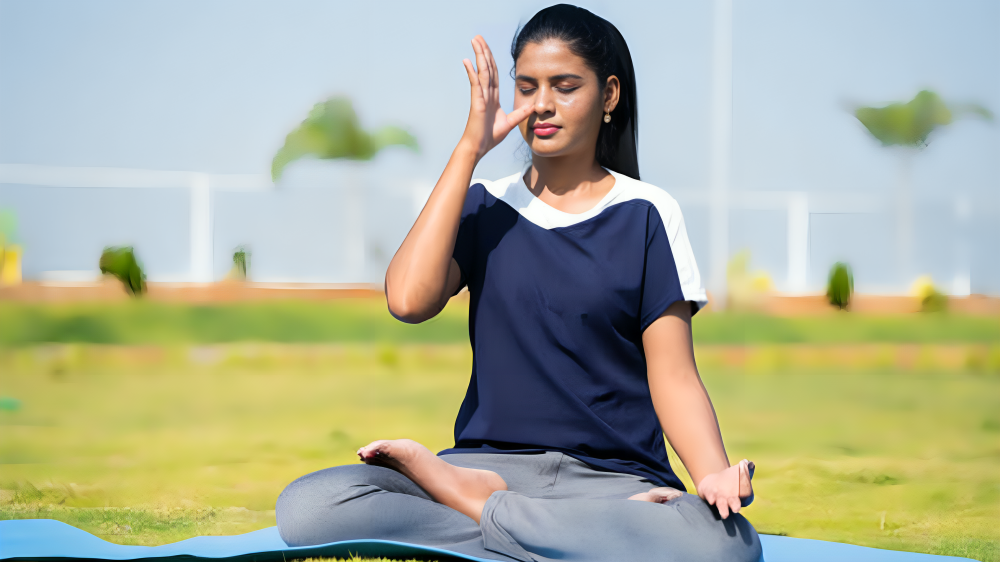
What is Ujjayi Pranayama?
Ujjayi Pranayama, pronounced “ooh-JAH-yee prah-nah-YAH-mah,” is a breathing technique used in yoga that involves constricting the throat slightly to create a gentle sound as you inhale and exhale. This practice is also known as “Ocean Breath” because the sound it produces resembles the waves of the ocean. It’s a central part of many yoga practices and is often used during poses to maintain focus and control.
How to Do Ujjayi Pranayama
Find a Comfortable Seat: Start by sitting in a comfortable position with your back straight. You can sit cross-legged on the floor, on a cushion, or on a chair with your feet flat on the ground.
Relax Your Body: Close your eyes and take a few normal breaths. Let your shoulders relax and settle into your seat.
Focus on Your Breath: Begin to focus on your breath. Notice how it feels as it enters and leaves your nostrils.
Constrict Your Throat Slightly: Now, gently constrict the back of your throat, as if you were about to whisper. You should feel a slight narrowing in your throat.
Inhale Slowly: Inhale deeply through your nose, keeping your throat constricted. You should hear a soft, whispering sound, like the ocean or a gentle snore.
Exhale Slowly: Exhale through your nose while maintaining the slight constriction in your throat. Again, you should hear the same ocean-like sound.
Find Your Rhythm: Continue breathing in and out like this, focusing on the sound of your breath. Try to make your inhales and exhales equal in length, creating a steady, rhythmic flow.
Practice Regularly: Start with just a few minutes of Ujjayi Pranayama and gradually increase the time as you become more comfortable with the technique.
The Benefits of Ujjayi Pranayama
Calms the Mind: The rhythmic sound of Ujjayi breathing can have a calming effect on the mind, reducing stress and anxiety. It’s like a lullaby for your nervous system!
Improves Focus and Concentration: By focusing on the sound and rhythm of your breath, Ujjayi Pranayama helps you stay present and mindful, enhancing your concentration.
Balances Energy: This breathing technique can help balance your energy levels, making you feel both relaxed and energized. It’s great for those days when you’re feeling sluggish or overstimulated.
Regulates Breath: Practicing Ujjayi Pranayama helps you develop a deeper, more controlled breath, which can improve lung function and increase oxygen supply to your body.
Supports Yoga Practice: Ujjayi Pranayama is often used during yoga to help maintain a steady breath and focus throughout the practice. It can make challenging poses more manageable and enhance your overall experience.
Promotes Detoxification: Deep, controlled breathing encourages the release of toxins from the body, promoting overall health and well-being.
Relieves Tension: The soothing nature of Ujjayi breathing can help release physical tension, particularly in the chest and shoulders, where many of us tend to hold stress.
It’s here Bhramari Pranayama how to do it and what are the benefits
FAQ’s
1. Can beginners practice Ujjayi Pranayama?
Absolutely! Ujjayi Pranayama is suitable for beginners. Start slowly and gently, and over time, you’ll develop more control over your breath.
2. How long should I practice Ujjayi Pranayama?
You can start with 3-5 minutes a day and gradually increase the time as you get more comfortable. Some people practice it for 15-20 minutes or even longer!
3. Can I practice Ujjayi Pranayama while lying down?
Yes, Ujjayi Pranayama can be practiced while lying down, especially if you’re using it for relaxation or before sleep. Just make sure your spine is straight and your body is relaxed.
4. Is there a best time to practice Ujjayi Pranayama?
You can practice Ujjayi Pranayama at any time of day. Many people find it helpful in the morning to set a calm tone for the day or in the evening to unwind before bed.

